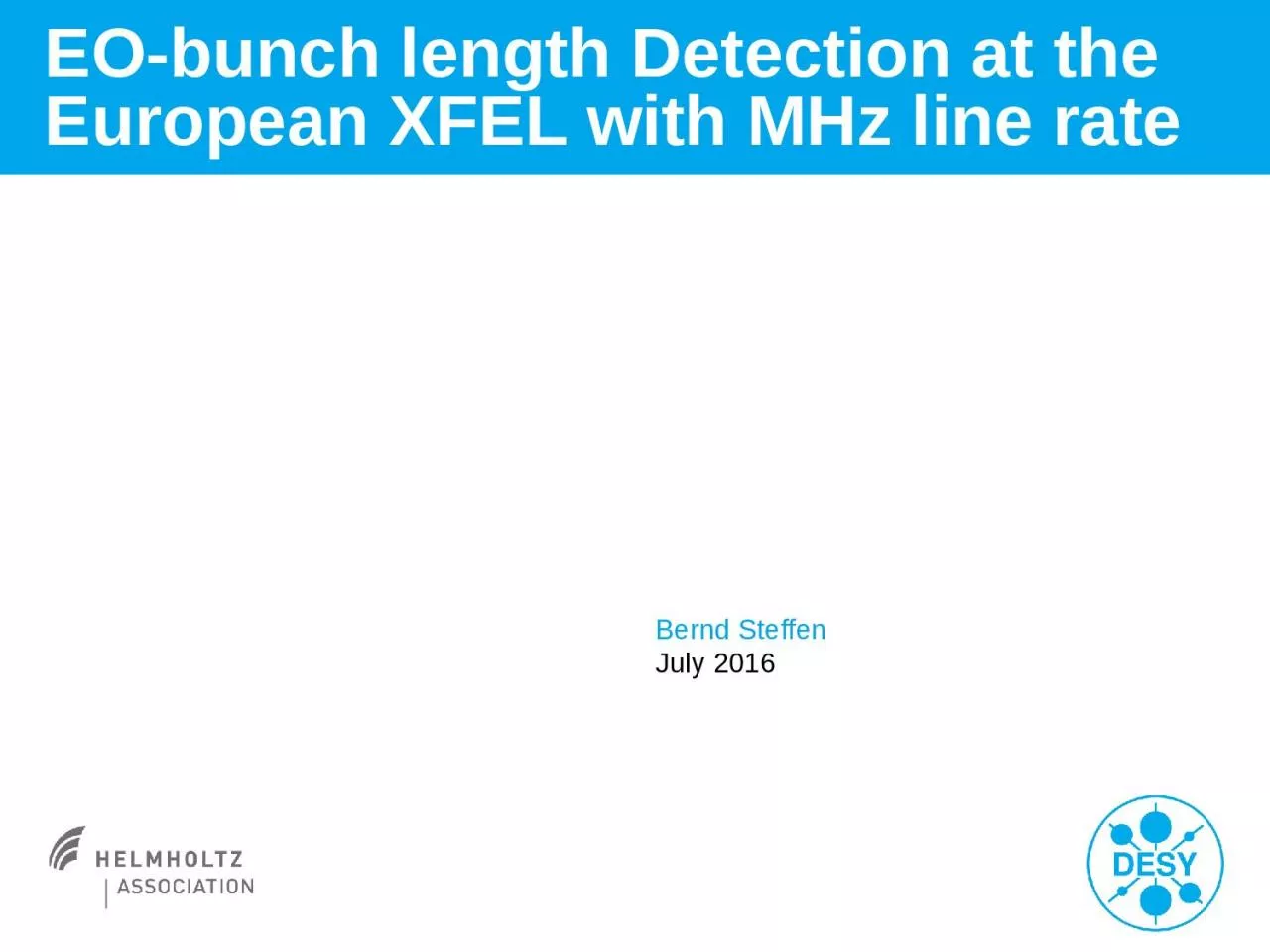

MHz line rate Bernd Steffen July 2016 ElectroOptical bunch length Detection at EXFEL Injector with 1 MHz bunch rate For the ElectroOptical bunch length Detection EOD the electric field of the electron bunch is sampled with an fs laser pulse in an Gallium Phosphide crystal ID: 914751
Download Presentation The PPT/PDF document "EO-bunch length Detection at the Europea..." is the property of its rightful owner. Permission is granted to download and print the materials on this web site for personal, non-commercial use only, and to display it on your personal computer provided you do not modify the materials and that you retain all copyright notices contained in the materials. By downloading content from our website, you accept the terms of this agreement.
Slide1
EO-bunch length Detection at the European XFEL with MHz line rate
Bernd Steffen
July
2016
Slide2Electro-Optical bunch length Detection atE-XFEL Injector with 1 MHz bunch rate
For the Electro-Optical bunch length Detection (EOD) the electric field of the electron bunch is sampled with an fs laser pulse in an Gallium Phosphide crystal.
With the KALYPSO line detector EOD can provide bunch length measurements with 1.13MHz rate over the XFEL bunch train.
Full
system (including laser, detector, MTCA crate, synchronization electronics, motor drivers, power supply, ect.) mounted in climatized 19” rack underneath the beamline
First system now ready for (expert) operation at the XFEL-injector
Slide3Electro-optical bunch length diagnostics at E-XFEL
before BC1 (2.5ps
gaussian
)
b
efore BC2 (300fs
gaussian
)
Injector (simulation)
before BC2 (simulation)
Slide4Electro-Optical bunch Detection
Electro-optical spectral decoding
f
t
Chirped laser
pulse
:
Defined relation between
time and frequency
f
t
Sampling with laser pulse:
Sample electron bunch
with many laser pulses
Slide5The compact
Yb
-fiber laser for electro-optical bunch detection at PSI / DESY / KIT
Yb
fiber
laser specs
wavelength
1030 nm
bandwidth (
osc.)
25nm – 50nm (up to 100nm with ampl
.)chirped laser pulse length
5ps (compressible to <100fs)pulse energy (osc.)
1
nJ – 2 nJ (up to 100 nJ
with apml. at 1 MHz)
repetiton rate54 MHzThe laser was originally designed at PSI for EOD to be compact and rack mountedFurther development at DESY (amplifier integrated into the laser box, synchronization, other electronics)Full system (including laser, detector, MTCA crate, synchronization electronics, motor drivers, power supply, ect.) now only 18 HU in 19” rack
Slide6EOD Beamline Unit
EOD
b
eamline
unit developed by DESY and PSI
Slide7Spectrometer with KALYPSO detector
Self build fiber spectrometer
19
”,
3HU
Approx
. 120nm range (adjustable)<1nm resolution
Kalypso detector256 pixel linear InGaAs PDA (900nm - 2.5µm) or Si (300nm-1050nm)Up to 1.3 MHz continuous line
rate2% noise (prototype)Sensitivity: few pJ for a good spectrum
Slide8Spectrometer with KALYPSO detector
Readout tester to 10k lines per bunchtrainDetector background and unmodulated laser measured with every train
laser with e-
plain laser
no laser
Slide9First EOD measurements
Slide10500 bunches at 1.13MHz
500 bunches 400pC dropping to 300pC
Data from a single bunch train
Bunch charge dropping from 400pC to 320pC over the bunch train
Bunch length and arrival time from fitted
gaussian
Slide11KLYPSO status
Prototype (KALYPSO v1) suffering from high noise (partially because we cannot change the bias voltage remotely) and bad pixelsA new version (KALYPSO v2) is in production, first test results shown by Lorenzo Rota later, board now at DESY
New FMC readout board at DESY (now also with bias control)
One silicon KALYPSO v2 is ready for TELBE.
New GOTTHARD chip design in preparation (readout chip between PDA and ADC)new charge sensitive amplifier --> to further improve SNR with both Si and InGaAs frame rate over 5
MHz (designed for 10MHz)fully differential readout chain --> to be more robust in term of noise
fully differential Correlated Double Sampling --> with the possibility to perform a balance detection inside the chipMore information from Lorenzo Rota and Michele Caselle
Slide12Current EOD status
EOD 1 in operation for expertsSoftware for automation neededMost parts for EOD 2 and 3 ready for installation (spectrometer currently being assembled)
Currently not many measurements due to lack in manpower
Slide13First EO Signal (finding temporal overlap with single photodiode readout)
Slide14First EO Signal (Thanks to Peters
Peiers
good
eyes…)
Slide15Wakefields
… over
more than a ns (Photodiode signal)
Slide16Slide17Expected EOD resolution
EOD at E-XFEL
position
injector
injector
(
alternativ
config.)before
BC1
after BC1lower BL limit for EO-SD
energy
MeV150150
600600
2000
expected bunch length (used for parameter optimization)rms,
ps8
82.50.30.15crystal thicknessmm555
2
0.5
chirped laser pulse length
FWHM,
ps
20
10
6
2
0.5
min. measurable bunch length
rms
,
fs
500
300
250
150
100
minimum charge
nC
0.25
0.25
0.05
0.05
0.10
resolution
rms, fs
400
200
100
50
30
useful time
window (max.)
ps
30
15
9
3
0.75
before
BC1 (2.5ps
gaussian
)
after BC1
(
300fs
gaussian
)
Injector (simulation
)
after
BC1 (simulation
)
Slide18Detector calibration:
Laser full power (HWP:45deg): 2mW@1MHz -> 2nJ/pulseAbout 50% transmission through spectrometerMeasured at 4deg -> 2%
About 20pJ at the detector, modulated by 10% by the e-field, measured with gain 4
Some 2%, 300kHz noise on the laser power
Slide19